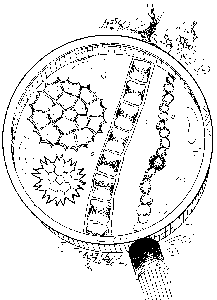Algae and water quality

The condition and characteristics of a lake can change over time because of natural processes. However, our actions both along the shoreline and within the surrounding watershed can also cause changes and even create water quality problems.
Nutrients used by algae, such as nitrogen and phosphorus, are necessary for them to grow, and our planet would be sterile without their success. However, big increases in nutrients in lakes due to human activities can cause algae to grow much more rapidly and become nuisances. Cloudy water, thick scums, and foul odors can make lakes unattractive for fishing, swimming, boating or even just hanging out on the beach.
Human activities, including gardening and daily household practices, septic and other waste treatment systems, agriculture, forestry, and land development, serve as pollutant sources and may have dramatic effects on lake water quality.
Green links in a great chain
Algae are tiny aquatic plants that are found as single cells or in colonies of various sizes. They make a primary link in the aquatic food chain, acting as food for microscopic animals called zooplankton. These tiny animals are eaten by many fish and other aquatic animals. As a by-product of photosynthesis, algae also release oxygen into the water that can be used by fish and other aquatic animals.
However, when large populations of algae are produced and then die, the process of decomposition also uses oxygen, which can limit its availability for other life in the lake.
An algae bloom is a sudden explosion of algal growth, typically encouraged by warm water temperatures, sunshine and an abundance of nutrients in the water column. Spring blooms are common in many lakes, as the days lengthen and nutrients are abundant from winter water inputs. Once the nutrients are used up, most lakes will settle into summer conditions with less algae. King County's lakes also sometimes experience summer blooms, if nutrients are still present. Fall blooms occur as winds and cooler temperatures mix lake water, bringing up nutrients from the deeper parts of the water column.
Blooms usually last several weeks, then "crash" as conditions change to limit their growth. Depending on the type of algae and its characteristics, a greenish scum may occasionally form on a lake's surface, sometimes causing a foul smell and taste to the water. Sometimes bluegreen algae blooms produce toxins that could be harmful to people, pets, and wildlife.
Be algae aware
If your lake's water looks like pea soup or has an offensive smell, it is probably undergoing an algal bloom. Lakeside residents and visitors should consider taking these steps:
- If a significant bloom is observed, notify King County Lake Stewardship Program to arrange a site investigation and possibly laboratory testing.
- Keep your pets away from the water, and in particular, do not allow them to drink it.
- Rinse off with tap water immediately after swimming in an algae-filled lake, and dry off vigorously with a towel.
- Never drink untreated lake water, regardless of its clarity or algae content.
Many lakes can have an occasional algae bloom over the years when conditions are just right, just like the perfect storm. However, repeated blooms throughout each year or having blooms that cause nuisance conditions should be investigated for deterioration of the ecosystem of the lake.
A lake management plan investigates a lake's physical, chemical and biological characteristics and identifies appropriate methods for controlling nutrients that stimulate algae. These might include such actions as reducing watershed nutrient sources from stormwater runoff, implementing lake-friendly lawn and gardening practices and maintaining on-site septic systems to regularly prevent nutrients from entering the water. In other cases, in-lake management actions such as alum treatments or hypolimnetic aeration might be appropriate.
Resources
Algae and King County Lakes [225KB PDF]
Michaud, J.P. 1991. A Citizen's Guide to Understanding and Monitoring Lakes and Streams. Puget Sound Water Quality Authority, Olympia, WA.
Taggart, J. and B. Bracht, 1991. Your Guide to Preventing Water Pollution. Terrene Institute, Alexandria, VA.
EPA, 1990. The Lake and Reservoir Restoration Guidance Manual, Second Edition (EPA-440/4-90-006). U.S. EPA Office of Water, Washington D.C.
Seattle-King County Department of Public Health, 1993. About Swimmer's Itch brochure.
Crayton, M. A. 1993. Toxic Cyanobacteria Blooms: A Field/Laboratory Guide. Office of Toxic Substances, Washington Department of Health, Olympia, WA.
For questions about lakes in King County, please contact lakes@kingcounty.gov or call the Water and Land Resources Division front desk at 206-477-4800.

 Translate
Translate